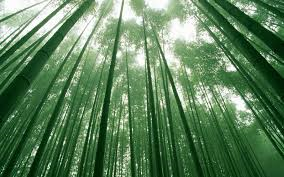Bamboo (Bambuseae) is a tribe of flowering perennial evergreen plants in the grass family Poaceae, subfamily Bambusoideae, tribe Bambuseae. Giant bamboos are the largest members of the grass family.
In bamboos, the internodal regions of the stem are hollow and the vascular bundles in the cross section are scattered throughout the stem instead of in a cylindrical arrangement. The dicotyledonous woody xylem is also absent. The absence of secondary growth wood causes the stems of monocots, even of palms and large bamboos, to be columnar rather than tapering.
Bamboos are some of the fastest-growing plants in the world, due to a unique rhizome-dependent system. Bamboos are of notable economic and cultural significance in South Asia, Southeast Asia and East Asia, being used for building materials, as a food source, and as a versatile raw product.
High-quality bamboo is stronger than steel, a property that has made it a choice in building materials and weaponry.
| Bamboo | |
|---|---|
 |
|
| Bamboo forest in Kyoto, Japan | |
| Scientific classification | |
| Kingdom: | Plantae |
| (unranked): | Angiosperms |
| (unranked): | Monocots |
| (unranked): | Commelinids |
| Order: | Poales |
| Family: | Poaceae |
| Subfamily: | Bambusoideae |
| Supertribe: | Bambusodae |
| Tribe: | Bambuseae Kunth ex Dumort |
| Subtribes | |
|
See the full Taxonomy of the Bambuseae. |
|
| Diversity | |
| Around 92 genera and 5,000 species | |
Bamboo in Japanese art
-
Japanese textiles, paintings, calligraphy and many other art genres incorporate many spiritually significant motifs, including the bamboo tree.
Kimono and obi textiles often include scenes with the Three Friends of Winter or the bamboo tree alone, admired as a symbol of permanence and delicate beauty.
Even the seed of the bamboo tree is imbued with significance in its ties to the phoenix, a mythical creature representing wisdom, immortality and compassion that is often depicted in Japanese arts. The myth says that the phoenix eats only bamboo seeds.
Special uses of bamboo
-
Bamboo’s spiritual significance in Japanese culture is also reflected in its exclusive use in creating contemplative, decorative items for shrines and temples. Water fountains and spouts made of bamboo originated in Japan; they enhance the spiritual reflection or meditation sought by temple visitors.
One traditional Japanese bamboo fountain, the Tsukubai, is said to embody and illustrate purity and sacredness.
History
-
References to bamboo in Japanese culture go back to the 10th century when a popular Tale of the Bamboo Cutter began. Since then, bamboo has been heralded as one of the finest materials used in making ladles for wash basins, chopsticks, blinds, bows and arrows and more.
As demand for bamboo increased, it was also incorporated into musical instruments, items for the sacred Japanese tea ceremony, tools for martial arts and items for flower arranging. Bamboo is also used in building tea houses and making flower vases, pitchers, fences and many architectural elements to enhance structural beauty.
Read more: http://www.ehow.com/about_6673970_spiritual-significance-japanese-bamboo-tree.html#ixzz2nUojXME9
The symbolism of bamboo in Asian culture
The mystique and beauty of the bamboo forest is one of the most common themes for paintings and jade carvings, and bamboo forests have been used as atmospheric backdrops in many movies. For example, the Oscar-winning “Crouching Tiger, Hidden Dragon”, directed by Ang Lee, was partly filmed in a bamboo forest.
In Chinese culture, the bamboo, plum blossom, orchid, and chrysanthemum (often known as méi lán zhú jú) are collectively referred to as the Four Noble Ones. These four plants also represent the four seasons. The pine tree, the bamboo, and the plum blossom (song zhú méi) are also admired for their perseverance under harsh conditions, and are together known as the “Three Friends in Winter“.
PLUM BLOSSOM
In Japan, a bamboo forest sometimes surrounds a Shinto shrine as part of a sacred barrier against evil. Many Buddhist temples also have bamboo groves.
ORCHID
In Vietnam, bamboo symbolises the spirit of Vovinam, a Vietnamese martial art, the hometown and qualities of the Vietnamese soul. A Vietnamese proverb says: “When the bamboo is old, the bamboo sprouts appear”, meaning that Vietnam will never be destroyed because if the previous generation dies, the children will take its place.
CHRYSANTEMUM
Several Asian cultures believe that humanity emerged from a bamboo stem. In the Philippine creation myth, legend tells that the first man and the first woman each emerged from split bamboo stems on an island created after the battle of the elemental forces (Sky and Ocean). In Malaysian legends a similar story includes a man who dreams of a beautiful woman while sleeping under a bamboo plant; he wakes up and breaks the bamboo stem, discovering the woman inside.
The Japanese folktale “Tale of the Bamboo Cutter” (Taketori Monogatari) tells of a princess from the Moon emerging from a shining bamboo section. Hawaiian bamboo (‘ohe) is a kinolau or body form of the Polynesian creator god Kane Milohai.
Inspiring Secrets About Persistence & Success -Bamboo Tree
Uploaded on May 11, 2007
The inspiring story of the Bamboo tree is much like Life itself – you have to have faith, belief and persistence. It also is a story of stability, structure, and maturity.
In becoming a successful entrepreneur, growing company, or even growing as a person, remember to always be watering your tree, planting roots, and building your foundation.
With persistence, rewards will follow! Never give up!
We ALL are ONE!!
We ALL are connected through NATURE!!









